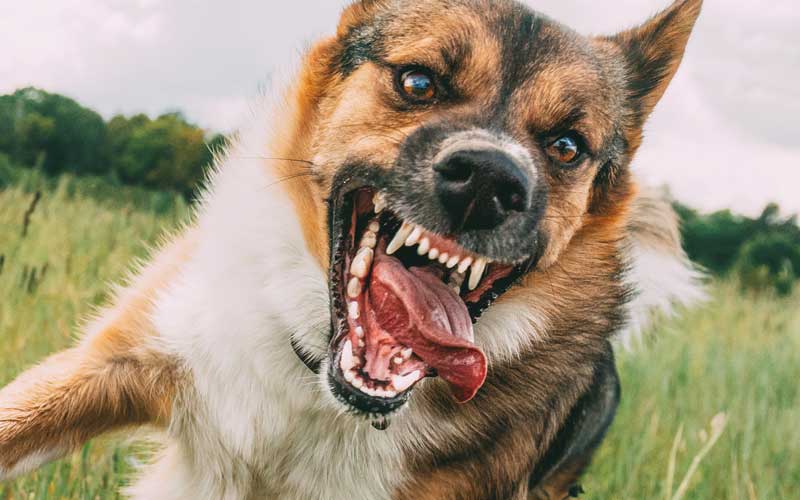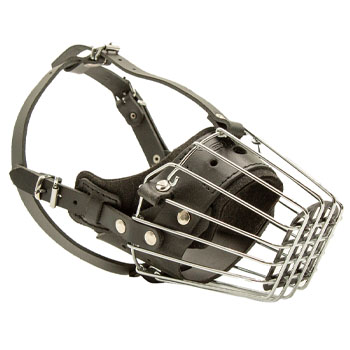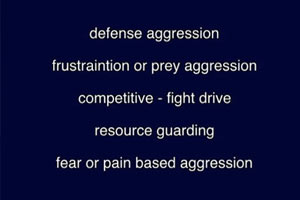What Would I Do If Attacked by a Dog?

This is a 2-part article.
- The first part deals with what I (as a professional) would do if I were attacked by a dog.
- The second part deals what the average pet owner should do if they or their pet are attacked by stray dogs.
What Would I Do?
I was recently asked what I would do if I were attacked by a dog. The question was not what someone else should do if they were attacked, but what I, as a professional, would do.
It's important to understand that I am a professional dog trainer. In 1978, I started breeding working bloodline German Shepherds. During the 80s, I competed in AKC obedience, tracking competitions, and Schutzhund where I titled a number of dogs. I started working with police service dogs in the late-80s and became a K9 handler for the local Sheriff's department and the regional drug task force.
I retired from breeding after 35 years and now devote my time to producing online courses, hosting seminars with expert trainers, and curating the best dog training equipment for passionate dog trainers. As you can see, I have a hand in understanding dogs. What I would do when being attacked by a dog will differ greatly compared to the average pet owner.
With that said, the one thing that people need to understand is that 99.99% of the dogs that attack and kill humans are dogs with weak nerves or extremely dominant dogs with no training. These are not trained dogs with solid temperaments. Even so, I will address both kinds of dogs.
99.99% of the dogs that attack and kill humans are dogs with weak nerves or extremely dominant dogs with no training.
I will start by saying that it only takes me a few seconds to evaluate a dog as it approaches. I can tell from a dog's body language and eyes if it's a sharp, nervous dog.
With sharp dogs, simply facing the dog with a loud, deep-throated confident “NO!” will often be enough to stop the dog in its tracks. Most will turn and leave. These are not strong dogs that want to fight a human. They are weak dogs who show aggression because they have learned that aggression makes people leave them alone. Dogs from this category that don't turn and leave will stand off and bark. I would continue to stare at those dogs and give them a loud "NO, GET TO THE HOUSE!" Eventually they will slink off and leave, trying to act tough as they go.
Dogs like this are the ones who have the hair up on their back as they approach. They may (or may not) show a lot of teeth. Their body posture is not forward and they will stand with their feet apart because they are preparing for "fight or flight” mode. If I can stop these dogs with my voice, I will pause and give direct eye contact for a second and then take a quick step toward the dog, yelling in a strong confident voice. The majority of them will bolt into flight.
These nervous dogs that don't bolt will bark and circle as they try to get at you from behind. Simply turning and facing them with direct eye contact is going to prevent this. Very, very, very few dogs are going to do this, at least not to me anyway. Dogs sense strength and confidence in my body posture, eye contact, and voice. For those dogs that don't leave after a minute, I can slowly (and I mean slowly) back out of their territory. Which, depending on the dog, could possibly be quite some distance. I testified in court several years ago against a lady in Kansas whose Rotts killed an 11-year-old boy. These dogs were allowed to roam the neighborhood. They considered their territory several blocks around their home. This woman is now serving 12 years in prison. It's too bad that she will not spend more time there. She had no remorse.
The average person can do the same thing that I do when they are confronted by a nervous dog. What they don't want to do is turn and run. No matter how scared you are, you can't outrun a dog. On top of that, running will only trigger prey drive and increase the possibility of an attack and being bitten.
The second group of dogs, (those that know how to fight humans), are a different situation. The only way to deal with an attack from these dogs is to climb a tree or fight them.
As the dog approaches, I would square off and offer a target: my left arm. Trained dogs have almost all been started on left arm bites. I would stand in a balanced position similar to someone trained in karate. As the dog approaches, usually at a run, I would wait until the dog is about 3 meters away and swing my arm up (in front of and across my body). This movement will trigger the dog's prey drive and it will target the arm. As I do this, I quickly pivot to the side and jerk the arm away just as the dog was about to grip the arm. This is done when the dog is in the air with his mouth open—in other words, "at the last possible instant." Making the dog miss his grip obviously takes a little experience and coordination but it can be done. It's surprising how focused one can be at times like this.
As the dog goes flying by, I would try and disable the dog with a strong kick to the back of the ribs or groin. Odds are, this would not work. The majority of these dogs will turn and attack again. The second time will not allow as much planning. I have been successful in 3 passes of a dog before it was stopped by its owner. When an untrained dog misses a bite three times in a row, its nerves get turned on. When that happens, these dogs can be pushed into flight with an aggressive move towards them.
I have no idea how many times in the past 20 years that I have fought police dogs in muzzle fighting training. More than I can remember. I can say that the more experience one has, the better you get at fighting dogs. I have run tough KNPV trained dogs that were sent after me in muzzle.
With that said, the more experience a dog gets at fighting humans (Schutzhund training is not considered fighting humans), the better they get too.
What gets difficult is when an experienced dog goes for your legs. Most police dogs that have bitten a lot of people will learn that leg bites are more successful than arm or upper body bites. They figure out, through experience, that the last part of the body to move are the legs. French Ring dogs know this too. But most French Ring dogs would not bite a person if their life depended on it (kind of reminds me of the French government). One of my best friend's police dog broke a criminal's leg when he hit him at a dead run. This dog figured out that the weight-bearing leg was the best target. He had over 200 street bites and the majority of them were leg bites.
You can make these dogs miss but you need to be quick. The older I get, the slower I get. So I guess at this point, I would have to go to "Plan B" (which is nasty). In Plan B, you have to let the dog bite you. You just have to suck it up and take a bite. Chewing on your lip helps, but I heard of a bad criminal who bit through his own lip when a police dog bit him because he did not want to scream and let the K9 officer know where he was hiding. They still found him - he just had a hole in his lip and several in his leg.
Of course, there is always the possibility of taking the leg bite and then trying to choke the dog out. The key here is to not stop choking when the dog passes out. When dominant dogs are choked out in a fight drive, they wake up and are still in fight drive. These dogs will wake up (usually pretty quickly) and if you are still there, they will come after you again. So when the dog is passed out, you'll have to either secure it as fast as possible or finish the job (choke him until they are dead).
I can see all the PETA people here rolling their eyes, clutching their chest and saying I am worse than mink farmers. If you are a PETA member and it makes you feel better, I will say that there are police dogs out there that no man is going to beat. I can't tell you how many tough guys have shot their mouth off about being able to beat a police dog with his bare hands only to cry like a baby when the dog bites him in his armpit or upper inner thigh.
My grandmother once told me a very important statistic. "You have 20 times more chance of being hit by lighting than being attacked by a trained dog." Grandma was always great with statistics and making chocolate chip cookies. I cannot say that you would have the same odds with nervous dogs and irresponsible owners that allow them to run free.
I get asked about Schutzhund dogs (sport dogs) all the time and the truth is that the vast majority of Schutzhund dogs will never bite a person without a sleeve on. Sport dogs require weeks of additional training to convert them to police service dogs.
Sport dog training is actually good for dogs. It helps them relieve the stress in their lives (similar to us going out to play a game of racquetball). The training also teaches them when they can and cannot bite. Now there are always exceptions to this rule, like the lady I testified against in Kansas. Her male Rott (the pack leader), was Schutzhund trained.
I have talked with friends about what the lady from San Francisco could have done to prevent her death when she was attacked by the Presa Canario. In my opinion, there is probably nothing she could have done to save herself. These dogs had already had confrontations with her in the past and therefore they knew that she was afraid of them. So the option of facing them off was not there. The woman only weighed 110 pounds and the male dog (if my memory is correct) outweighed her by 50 pounds. She was attacked in the hall of her apartment and did not have any place to get away from the dog. I am not even sure if pepper gas would have stopped this dog. The only thing that may have worked would have been to drop to the ground, curl up in a ball with your hands clasped behind your neck and your arms and elbows protecting your neck and throat. Not many people can keep their wits about them when they are being bitten this badly. They go into flight mode and try to get away. I was pleased to see the owners of these dogs were also sent to prison to spend some time with their drug-dealing friends.
If anyone that is reading this article lives in a similar environment (near aggressive dogs) you should always carry pepper gas and a walking stick. In fact, if you have to walk by a house or apartment with aggressive dogs, get it out and have it in your hand. If an attack comes you will not have time to fish around in your purse or pocket.
What To Do If You or Your Pet is Attacked by Stray Dogs
I get a lot of emails from pet owners who are out walking their dogs when stray dogs come out of nowhere and attack their dog. This is not an uncommon occurrence! When this happens, the pet owner needs to be assertive. Sometimes (not always) if you are lucky, simply taking a step forward and screaming no at the dog in a confident tone of voice will turn the stray around.
More often than not, the strays will come in to either attack or to posture over your dog. If your dog is at all annoyed by this, the stray will attack to show his dominance.
This is where the owner needs to be prepared. He or she should have a stout walking stick along with pepper gas or both. If a dog will not back off with verbal threats, then it's time to get cracked right between the ears. The harder the better.
I continue to hit a dog until it backs off. If that means 3 hits or 10 hits. I will not allow a stray dog to hurt or kill my dog. As a pack animal, your dog expects you as the pack leader to protect him. So hang in there and whack the snot out of the stray. If the owner of the other dog is there, don't allow this to intimidate you. If they don't jump right in to pull their dog off, then whale on their dog.
When the aggressor finally comes off, get your pepper spray out. If the dog does not turn and leave. Spray the dog right in the nose. Empty the can on the dog. Pepper spray will not always have the same effect on dogs that it does on humans, but it does give them all something to think about other than trying to kill your dog.
After the Attack
Now it's time to go into the prevention phase of dog attacks. The first thing to do is to talk to the owner. Start with a sincere attitude. Maybe this truly was an accident where the owner was responsible but something happened and the dog got out.
But if the owner is a dink, then you need to go to the next level. Call animal control or the police. Insist that a police report be written by the office. If the dogs are picked up, then the owner has to claim them. If it means that these animals are put to sleep because the owner will not pay the fine, then so be it. They are a danger to the community and they are in the hands of an irresponsible owner.
If the officer will not write one, ask who his or her supervisor is and talk with them. You need to continue to go up the ladder of authority until you get results.
If law enforcement will not write a report or issue a citation, then go to the DA and explain what happened. Ask to see copies of your local dog laws. You can also ask to see copies of the state dog laws. The state laws are often stricter than the local laws.
It may be a good idea to talk to the neighbors of the stray dog owners (if you can find them). See if this is a common occurrence. Document your findings and build a case on facts.
Maybe it's time that you get involved in passing strong dog laws in your community. Make sure the language in the law includes dogs that attack other animals in addition to humans. Lobby for this in your community. Leave petitions around the various businesses.
If you are not happy with the DA's response, tell him you are going to talk with the Mayor or local councilmen. That's if they do not do something about this situation. Plan on taking your case to the media. Write a well-thought-out letter to the local TV station and newspaper. Maybe it's time for the public to pressure these officials to put more emphasis on dangerous dog laws.
Elected officials seem to pay attention when their name is associated with a lack of interest in public safety.













Ask Cindy.